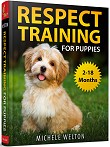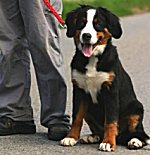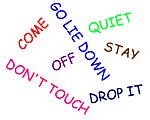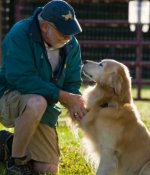Border Terriers: What's Good About 'Em, What's Bad About 'Em
Border Terrier temperament, personality, training, behavior, pros and cons, advice, and information, by Michele Welton, Dog Trainer, Behavioral Consultant, Author of 15 Dog Books

Inside your home, the Border Terrier is milder-mannered than most terriers. Yet in the field, hunting small animals, he is described as "hard as nails, game as they come, and driving in attack."
Some individuals are more work-oriented (not good pets) while others are more mellow (can be good pets if their other needs are met).
In general the Border Terrier is energetic and athletic. He tends to play rough and prefers vigorous exercise and interactive games.
But he should not be let off-leash, for there is no terrier more determined to explore and pursue anything that runs (except, perhaps, for the Jack Russell). Border Terriers are so inquisitive they often get themselves wedged into tight holes or crawlspaces trying to find out what's in there.
A secure yard or kennel run is essential for this breed, unless you adopt a more laid-back adult who has already proven himself to stay put and not try to escape.
Most Border Terriers who have been extensively socialized are bouncy and kissy with strangers, though there is timidity in some lines.
Unlike most terriers, the Border is usually sociable with other dogs and not given to fiery posturing. But he may or may not live peacefully with the family cat, and he is a business-like hunter of anything else.
Generally willing to please and sensitive to correction, the Border Terrier responds nicely to training that includes a lot of praise and encouragement. Motivate with food in moderation – Borders live for food and can become pudgy if over-indulged.
If you want a dog who...
- Is small, but sturdy and tough – not a delicate lapdog
- Has a natural appearance – unexaggerated and rather plain-looking
- Has a coat that's easier to groom than most other wirehaired terriers
- Doesn't shed too much
- Likes vigorous exercise and athletic activities
- Is sociable with strangers and other dogs, and not given to fiery posturing like many other terriers
A Border Terrier may be right for you.
If you don't want to deal with...
- The dynamic terrier temperament (see full description below)
- Providing enough exercise and activities to keep them busy
- Very strong instincts to chase other living creatures that run
- Stubbornness (mind of his own)
- Digging holes
- Barking
A Border Terrier may not be right for you.
 |
Dog Breed Traits – Which Traits Are Right For You? In this brand new series, I'll help you decide which dog breed traits would best suit you and your family, your home and yard, and your lifestyle, so you can choose the best dog breed for your family. |
Keep in mind that the inheritance of temperament is less predictable than the inheritance of physical traits such as size or shedding. Temperament and behavior are also shaped by raising and training.
FREE eBooks by Michele Welton
![]() "Respect Training for Puppies" and "Teach Your Dog 100 English Words" are free step by step guides to teaching your pup to be calm and well-behaved.
"Respect Training for Puppies" and "Teach Your Dog 100 English Words" are free step by step guides to teaching your pup to be calm and well-behaved.
![]() "11 Things You Must Do Right To Keep Your Dog Healthy and Happy" is a free guide to keeping your dog mentally, physically, and emotionally happy and healthy so you can enjoy a longer lifetime of companionship.
"11 Things You Must Do Right To Keep Your Dog Healthy and Happy" is a free guide to keeping your dog mentally, physically, and emotionally happy and healthy so you can enjoy a longer lifetime of companionship.

- You can avoid some negative traits by choosing an ADULT dog from an animal shelter or rescue group. With an adult dog, you can easily see what you're getting, and plenty of adult Border Terriers have already proven themselves not to have negative characteristics.
- If you want a puppy, you can avoid some negative traits by choosing the right breeder and the right puppy.
More traits and characteristics of the Border Terrier
If I was considering a Border Terrier, I would be most concerned about...
- The dynamic terrier temperament. Most terrier breeds are remarkably similar. The same words are used over and over – quick to bark, quick to chase, lively, bossy, feisty, scrappy, clever, independent, stubborn, persistent, impulsive, intense.
- Providing enough exercise and mental stimulation. Most Border Terriers are active go-getters. I recommend that you get your Border Terrier involved in regular obedience classes at the intermediate or advanced level, or in ongoing agility classes (an obstacle course for dogs). Or join an earth dog club, where terriers are encouraged to dig and tunnel after small critters (which are secured in a sturdy cage so they can't be harmed).
- Potential animal aggression. Border Terriers are considerably less scrappy toward strange dogs than many other terrier breeds. But they are still a determined force to reckon with if they decide to initiate or accept a challenge to fight. Most terriers have strong instincts to chase and seize small fleeing creatures. This can make for conflict if you own a cat. It may be much worse than that if you own a pet rabbit or hamster!
- Yard security. Terriers need a fenced yard in which to stretch their legs, but many terriers are clever escape artists who will go over or under fences in search of adventure. You may need higher fences than you might imagine for their small size. You may also need to sink wire into the ground along the fence line to thwart digging.
- Running away from you. Like all dogs, Border Terriers must be taught to come when called. But I would only count on this breed obeying his training in an enclosed area. Terriers should not be trusted off-leash. The risk is too great that they will take off after anything that runs, oblivious to your frantic shouts.
- Potential barking. Terriers are often too quick to sound the alarm at every new sight and sound. You have to be equally quick to stop them.
- Mind of his own. Border Terriers are more willing to work with you than many other terriers. Many excel at the highest levels of obedience and agility competition. But the toughness that makes them suited to killing vermin can frustrate you when they decide to be stubborn. You must show them, through absolute consistency, that you mean what you say.
To teach your Border Terrier to listen to you, "Respect Training" is mandatory. Read my free online training programs.
- Grooming. Border Terriers require clipping and trimming every few months. Breed purists may say that terrier coats should never be clipped because it makes the coat softer and more prone to matting. Instead they advocate hand-stripping (each dead hair pulled out so a new one can grow in its place). But in my opinion, stripping is too time-consuming and uncomfortable for the dog. Many groomers won't do it anymore. For pet dogs, I think clipping is just fine.
- Potential defensive reactions. If you need to physically chastise a terrier, and you go beyond what THEY believe is a fair correction, terriers (as a group) are more likely than other breeds to growl or snap. As an obedience instructor, I have never had this happen with a Border Terrier, but I'm always extra careful when putting my hands on any terrier for a correction.
I do not recommend terriers for homes with very young children. Many terriers will not tolerate any nonsense from little life forms whom they consider to be below themselves in importance. Many terriers are quick to react to teasing, and even to the normal clumsiness that comes with small children (accidental squeezing of their ears or pulling of whiskers or stepping on their paw). Many terriers are possessive of their food and toys and will defend these from all comers, including children.
My best-selling books – now available FREE on my website
 Respect Training For Puppies: 30 seconds to a calm, polite, well-behaved puppy is for puppies 2 to 18 months old. Your puppy will learn the 21 skills that all family dogs need to know. Click here to read for free.
Respect Training For Puppies: 30 seconds to a calm, polite, well-behaved puppy is for puppies 2 to 18 months old. Your puppy will learn the 21 skills that all family dogs need to know. Click here to read for free. Teach Your Dog 100 English Words is a unique Vocabulary and Respect Training Program that will teach your adult dog to listen to you and do what you say. Click here to read for free.
Teach Your Dog 100 English Words is a unique Vocabulary and Respect Training Program that will teach your adult dog to listen to you and do what you say. Click here to read for free. 11 Things You Must Do Right To Keep Your Dog Healthy and Happy helps your dog live a longer, healthier life. Get my honest advice about all 11 Things before you bring home your new puppy, because some mistakes with early health care cannot be undone. Click here to read for free.
11 Things You Must Do Right To Keep Your Dog Healthy and Happy helps your dog live a longer, healthier life. Get my honest advice about all 11 Things before you bring home your new puppy, because some mistakes with early health care cannot be undone. Click here to read for free.Related posts you might enjoy






